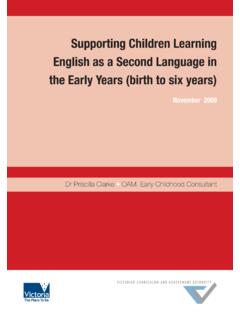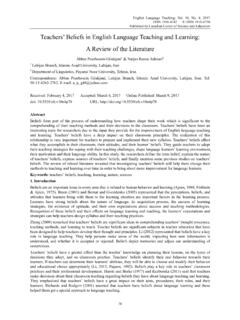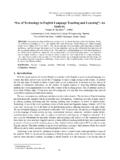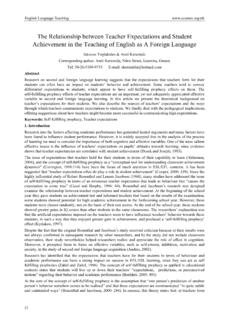Transcription of The Importance of Teaching Probability
1 1 The Importance of Teaching Probability A Brief produced at the Park City International Seminar Park City Mathematics Institute July 3-8, 2017 Introduction To adequately function in society, citizens need to overcome their deterministic thinking and accept the existence of fundamental chance in nature (Batanero et al., 2016). Moreover, more and more jobs use data that require citizens to make interpretations and decisions. Such skills necessitate the need for the development of probabilistic thinking. This need to learn Probability for citizenship has been recognized by educational authorities in many countries. As a consequence, in the latter years, Probability has been included in the official curriculum of many countries. Nevertheless, while Teaching Probability is becoming more important, there seems to be a lack of probabilistic knowledge and the understanding of the difference between Teaching mathematics, Probability and statistics.
2 Teachers are confronted with three main problems: what does it mean to teach Probability ; why is Teaching Probability important; and, what tensions, challenges and concerns may emerge when Teaching Probability . Thoughts about the possible answers to these problems are presented in the next sections. What does it mean to teach Probability ? Teaching Probability is finding probabilistic knowledge, pedagogical and technological strategies and materials to engage students in order to: 1. develop critical thinking about the meaning of chance; and, 2. value the Importance of applying the concept of Probability in real life. Teacher professional development needs to be focused on these two educational goals and must involve designing, implementing and assessing probabilistic content aligned with their country s curricular guidelines, as well as considering students ages and individual needs.
3 Why is Teaching Probability important? The primary reason for Teaching Probability is to provide students with understanding and to develop their critical thinking about the role of Probability in their lives and in mathematics. Different approaches to Probability include the frequentist, classical, and subjective, among others (Batanero et al., 2016). Not all of these approaches have the same Importance in the K-12 curriculum, but the first two approaches are considered because they can allow students to experience both experimental and theoretical Probability , and to interpret the meaning of these probabilities. Students need to be able to compute probabilities of events, model random data, interpret the results and make decisions accordingly in a variety of real-life situations they are likely to meet.
4 2 Because Probability is not the same as much school mathematics, some tensions, challenges or concerns may emerge as a result of the need to move beyond the deterministic perception of mathematics and include the idea of chance, to comprehend the misconceptions that can emerge when understanding a real random situation, and to realize that applications go beyond the traditional computation of the Probability of simple and compound events. Moreover, teachers need to be supported in investing time and commitment to acquire the knowledge to teach Probability and to see the Importance of learning Probability . What tensions, challenges and concerns may emerge when trying to implement Teaching Probability ? Three main concerns and challenges may emerge when trying to implement the Teaching of Probability . These are: the connection between the natural and academic language of Probability , the development of quantitative literacy that includes the concept of chance and Probability , and the understanding of the complexity of the connections among mathematics, Probability and statistics.
5 These are elaborated below: Challenge 1: Connecting the Natural and the Academic Languages of Probability One challenge that may emerge is connecting students everyday intuitions of chance, expressed in their natural language, and the academic language of Probability . This could be a pathway to develop the formal knowledge of Probability from an informal one. There are different ways of working on the progression from informal to formal probabilistic knowledge. When using the natural language to express the idea of chance, problems may emerge in some classrooms and even entire countries. Some countries, such as the Philippines, do not have a natural word to express the idea of Probability and have to borrow from other languages, such as the Spanglish word for chance or possibility. Other cultures contextualize this idea using different words, phrases and expressions.
6 In some countries, the word chance can have more than one meaning: it can express ignorance, it can refer to the magical aspects or it can reflect the complexity of integrating many causes and elements. For example, in english the word hazard means danger. But, its etymological origin was azar , which still means chance in Spanish. a) An example of the evolution from the informal natural language to the academic language of Probability , progressing from likelihood to possibility (using percent) to Probability (using fraction or decimal) could be: It is most likely going to rain tomorrow. Eight out of 10 times it will rain tomorrow. The possibility of raining tomorrow is 80%. The Probability of raining tomorrow is b) The progression from the informal to the formal study of Probability can help the students construct new probabilistic knowledge using prior knowledge.
7 Below is an example of a problem based on this principle: 3 Mario enjoys playing basketball. He practices making three-point shots by shooting 100 balls everyday. The number of good shots Mario makes each day for 20 days are: 65, 30, 40, 45, 40, 47, 45, 50, 45, 70, 45, 50, 55, 55, 28, 25, 40, 69, 55, 60 Question 1: How many good shots do you think Mario will make on the 21st day? Question 2: If Mario continues to practice making these shots, do you think he can make 80 or more good shots at the end of 30 days? Question 3: If Mario practices regularly, what do you predict is going to happen to the number of good shots he makes in the long run? Questions such as these can help the students to critically think about the changes in the distribution of the number of good shots as the sample size increases.
8 Students begin with the experimental analysis of the frequencies to make the first predictions. Then they are asked to expand the sample size and predict the result in the long run. The critical thinking about the content and the strategies used to answer the questions could help the students develop an intuitive idea of the law of large numbers. Challenge 2: Including Probability in Quantitative Literacy The concept of quantitative literacy has evolved in the last decades due to the needs of the adult society. In the late 1990s, quantitative literacy was defined in IALS [International Adult Literacy Survey] as the knowledge and skills needed to apply arithmetic operations either alone or sequentially, using numbers embedded in printed materials. (OECD, Statistics Canada, 2011, p. 346). This is a broad paradigm that can easily include or exclude chance.
9 Currently, the world is dominated by digital technology that makes mathematics invisible in some cases. New demands for quantitative literacy have appeared, although it is still not a common expression in some countries. The challenge of connecting the intuition of chance and quantitative literacy is to understand that chance is part of daily life. We can proceed from the informal idea of chance to a formal way to make informed decisions in risk situations. The inclusion of chance in quantitative literacy can help find answers to daily questions, for example, questions about lack of water, extreme heat, food, illnesses, etc. To manage and understand the information coming from newspapers, magazines, research papers, etc., requires critical thinking in order to make good decisions. Meanwhile, the uncertainty and data category includes recognising the place of variation in processes, having a sense of the quantification of that variation, acknowledging uncertainty and error in measurement, and knowing about chance.
10 It also includes forming, interpreting and evaluating conclusions drawn in situations where uncertainty is central (Moore, 1997). From a cultural perspective, each number determines a quantity of objects and also describes the quantification of random phenomena in chance situations. Through this quantification, students should also be able to develop their interpretation, judgement and decision-making skills in real-life situations. 4 In summary, quantitative literacy includes the knowledge, skills and dispositions needed to understand, solve, model, judge and make decisions under certainty, uncertainty and concerning risk problems. These competencies emerge from the natural, social and cultural environments with the aim of empowering citizens to become part of the public sphere. Considering this view of quantitative literacy, the previous problem can be extended to include questions involving real data, critical thinking and risk management in a social environment.





